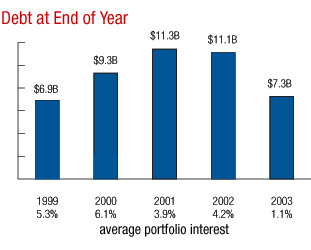|
Debt
The amount we borrow is largely determined by the difference between our cash flow from operations and our capital cash outlays. Our capital cash outlays are the funds we invest back into the business for our capital investments in new facilities, new automation equipment and new services. From 1997 through 2002, our outlays for capital investment exceeded cash from operations by $5.6 billion, so we covered the difference with borrowed funds. From the end of 1997, which was the lowest end-of-year debt level in the last 10 years, to the end of 2002, our debt outstanding to the Department of the Treasury's Federal Financing Bank increased from $5.9 billion to $11.1 billion.
Our debt management strategy has been
based on the assumption that we would
always have a core amount of debt outstanding.
Therefore, we have maintained a mixture
of fixed- and floating-rate debt, striking a
balance between short- and long-term debt.
Thus, as interest rates declined to historically
low levels during 2002, we shifted the balance
of our debt portfolio toward more fixed-rate,
long-term debt in order to protect ourselves
against future increases in interest rates.
Under this strategy, we began 2003 with $7.3
billion in long-term debt that carried a
weighted-average interest rate of 5.1%.
With the enactment of the Postal Civil
Service Retirement System Funding Reform
Act of 2003 (Act), we had to completely
change our debt management strategy. The
Act requires us to apply all cash savings we
realize under its provisions in 2003 and 2004
to debt reduction. In 2005, we must use any
savings to maintain steady postal rates and to
reduce debt. Congress has yet to state how we
are to use any savings realized after 2005.
We could have achieved the required debt
reduction for 2003 by paying off short-term
debt. However, the requirement for 2004, estimated
at $2.7 billion, would have been a
challenge because only $750 million of our
debt was scheduled to mature. In other words,
we would have had to prepay some long-term
debt before maturity at an unknown price. We
|
|
decided instead to retire more long-term debt
this year so we will have the flexibility to
reduce debt next year without a penalty.
The repurchase price of our debt depends
on the interest rates for Treasury securities
with maturity dates and terms similar to our
debt. If the interest rate for Treasury securities
falls below the level at which our debt was
issued, we have to pay a premium to pay off
our debt. If interest rates are roughly equivalent
to the interest rates at the time we
incurred the debt, we do not have to pay a
premium.
Before the passage of the Act, we had
already undertaken steps to refinance and
reduce our outstanding debt. In January we
paid off $777 million in long-term debt without
a net premium. In July, following enactment of
the Act, we retired an additional $547 million,
for a total of $1.3 billion. Because we did not
have to pay a premium to retire this debt, we
realized net savings from these transactions
immediately, through lower interest expense.
The weighted average interest rate for the
retired debt was 4.5%.
In August, we used more favorable market conditions to retire our remaining $6 billion of long-term debt by paying a premium of $360 million, a charge to this year's net income. The retired debt carried an average interest rate of |
 |
|



